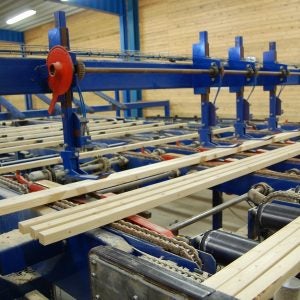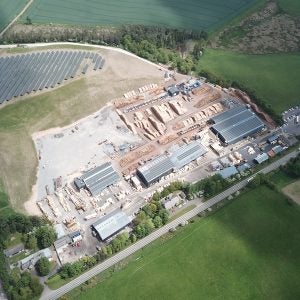The annual spring softwood conference gathering held by the Timber Trade Federation (TTF) is always a keenly anticipated date for the UK timber trade to gain a good view on how the market is shaping up.
With a refreshed agenda, wider appeal and new name – the UK Softwood Conference (previously Shippers’ Breakfast Meeting) – the event comprised speakers from the main timber supplying regions to the UK, the homegrown sawmilling sector as well as the housebuilding and joinery industries.
First up was Nick Moore of Timbertrends, who said UK softwood import volumes were up 5.2% in 2016 to 6.19 million m3. This compares to the pre-financial crisis peak of 7.9 million m3 in 2007. He said the level of growth was something of a “surprise” compared to original forecasts.
Most of the growth for softwood imports came in Q2 (+12%) and Q3 (+6%). Prices in Q1 had been down 8%, while in Q3 they grew 5% to £186/m3 and by 13% to £195/m3 in Q4. Sweden had a 43% market share of the softwood imports, followed by Latvia (17%) and Finland (14%). Latvia and Germany experienced growth in their UK exports of 13.3% and 15% respectively.
The latest figures available for timber consumption relate to 2015. In the UK construction market, homegrown timber accounted for 822,000m3 and imports 4.55 million m3.
The figures for the timber pallet and packaging industry were 1.008 million m3 and 401,000m3 respectively, while for fencing and outdoor markets the figures were 1.38 million m3 and 324,000m3.
The estimated UK timber consumption last year was 9.62 million m3, a growth of 5%, while UK timber production was up 4.4% to 3.6 million m3.
In a nod to the venue, Mr Moore was the first to quote Shakespeare with his look at the year ahead. “Modest doubt is called the beacon of the wise,” he shared from Troilus and Cressida.
“If anyone is bold enough to say they know what is going to be happening in 2017 they may end up looking very foolish.” He predicted UK production to rise 3.3% in 2017 to 3.72 million m3, with imports to move up 0.7% to 6.23 million m3. The key construction market is expected to consume 9.78 million m3 (+1.7%).
Swedish imports
Anders Ek, president of SCA Timber Supply, painted a picture of the Swedish sawmilling industry, saying that the country’s own construction industry was booming. Sweden enjoyed an incredible 60% growth in new housing in 2016, boosting the performance of its builders merchants.
“We saw very good construction growth in the world in 2016,” he said.
Softwood consumption growth in Sweden’s key markets last year showed the EU grew by 2.5%, Asia (+3%) and the US (+8%). Only the MENA region was not growing its consumption.
The prediction for the first six months of 2017 is 1.3% growth in the EU, Asia (+1.5%) and the US (+4%). Mr Ek said markets in North America and China were key drivers. “The whole world needs more wood than the world can produce,” Mr Ek added. “In the last seven years, world consumption of softwood has grown over 60%.” Growth in 2016 amounted to 12% compared to 2015. The bankruptcy of Hanjin Shipping – one of the world’s largest container transport companies – last year had an impact on the market. The subsequent spike in container prices to China meant Swedish timber shippers were more focused on moving timber volumes into Europe.
“We do not want to pay the freight rates [to China] at the moment,” said Mr Ek. As for stocks at Sweden’s sawmillers, they fell during 2016 and as at January this year were 5% below a year ago volumes, mainly due to falling redwood stocks.
The Baltics update was given by Janis Apsitis, from Kurekss Sia.
He said in 2016 some 992,000m3 of softwood was shipped to the UK from Latvia. He flagged up growth in the South Korean and Chinese markets.
Estonia’s timber industry exports were more focused on areas like timber frame housing and garden buildings, with 52,000m3 of softwood being exported to the UK. Lithuania’s UK softwood volumes were around 75,000m3. In total, that makes 1.05 million m3 total Baltics softwood exports to the UK in 2016, with 2.6 million m3 being shipped to other countries.
He forecasted export volumes to be up 3% from Latvia in 2016 and 12% from Estonia, but warned that availability of logs could significantly limit future growth in timber processing. Growing consumption of timber within the Baltics was another development, while demand for sawn softwood in central Europe and Asia was growing.
Jason Enticott, of UPM, shared initial Finnish sawmilling industry production figures for 2016 – a 7% growth to 11.4 million m3. The figure for January 2017 was up considerably on a year ago.
Egypt was Finland’s largest softwood customer in 2016, accounting for 1.3 million m3 (+7%), followed by China at 1.048 million m3 (+67%).
Mr Enticott said volumes to China were normally whitewood, but the country was starting to order redwood as well.
The UK was its fourth largest market at 640,000m3 (+7%). Total softwood exports were 8.086 million m3, a 10% rise.
Finnish Forest Industry Federation statistics show that sawn redwood volumes to the UK grew 5% to 392,000m3, while sawn whitewood grew 10% to 248,000m3.
“It’s been a busy start to the year with high production and stocks continuing to decline in redwood. All the markets are busy and hungry for raw material. There is a rather positive outlook despite the political and structural upheaval in global markets.”
Homegrown Timber
Keith Ainslie, of Scottish sawmiller James Jones & Sons, gave an update from the homegrown timber sector. “For UK mills it’s a pretty good news story,” he said. In 2016, UK mills grew their softwood production by 3% and Mr Ainslie predicted growth of 3-4% in 2017.
“The British mills had a very good January and a good February.”
He estimated the UK & Irish mills’ share of the UK softwood market at about 36%, compared to over 40% in 2007 before the financial crisis.
But despite the growth in 2016 there was an inconsistent picture with some mills doing better than others and domestic price increases lagging behind those of Scandinavian timber producers.
Post-Brexit currency movements have boosted demand for homegrown C16 construction timber.
Fencing remains the biggest individual market for the homegrown mills, followed by pallets/packaging and construction. He identified kilning capacity as the key constraint for further market development.
“There is an ongoing concern for small forest owners about the costs of FSC certification,” he added.
During a question time, Mr Ainslie said the FSC costs had led some mills to look at putting PEFC-certified timber into the market.
Joinery sector
British Woodworking Federation chief executive Iain McIlwee told delegates that most joinery companies the BWF speak to were “pretty flat out” at the moment. The timber window market, particularly, was growing with its market sharing increasing from 19% when the Wood Window Alliance launched in 2007 to 23% more recently.
Mr McIlwee said market challenges included uncertainty, competition from joinery imports, rising costs, a skills shortage and use of “fake wood” lookalike windows. The latter, he said had “started to eat into wood windows market position a bit”.
Next speaker Peter Hunt of Arbor Forest Products, identified Brexit, timber treatment and a lack of industry knowledge/training/ skills as three potential challenges to the UK softwood industry.
“We need to embrace and support the TTF and other bodies to encourage people to get into our industry because it’s an interesting industry,” he said.
“We cannot find qualified machinists for our planing mill. They’re just not out there any more so we have to take three apprentices in to train and we may keep one.” Giving a merchant’s perspective, Andrew Ferguson of Buildbase said the traditional merchanting business was facing challenges from the likes of Screwfix.
He said the Buildbase group’s timber products sales were worth £112m, comprising about £72m at Buildbase, with its subsidiaries T Brewer having a turnover of about £15m, Beaumont Forest Products (£12m) and L&G Forest Products (£12m).
Sales and margins in its timber division improved in 2016, with increased prices leading to higher sales figures. But he said margin pressures from new costs were increasing and difficult to pass onto customers.
Treated stock is becoming more popular in Buildbase’s northern regions, while its fencing is virtually all incised.
MDF mouldings continued to grow against solid wood, with Mr Ferguson saying this situation was changing almost every month. “I think the same thing could happen with decking. We’re starting to see more and more composites.”
He said the timber sector needed to up its game and guard against hard discounters in the trade. Supplying correct lengths and more finger-jointed and engineered wood that was fit for purpose was a necessity, he added. “I honestly believe we can do better.”






